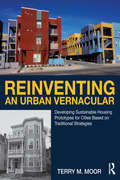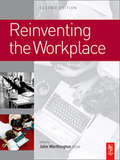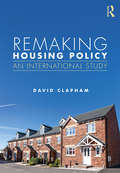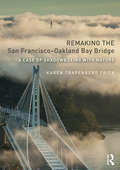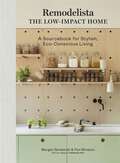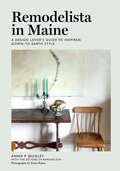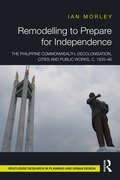- Table View
- List View
Reimagining Industrial Sites: Changing Histories and Landscapes (Routledge Research in Landscape and Environmental Design)
by Catherine HeatheringtonThe discourse around derelict, former industrial and military sites has grown in recent years. This interest is not only theoretical, and landscape professionals are taking new approaches to the design and development of these sites. This book examines the varied ways in which the histories and qualities of these derelict sites are reimagined in the transformed landscape and considers how such approaches can reveal the dramatic changes that have been wrought on these places over a relatively short time scale. It discusses these issues with reference to eleven sites from the UK, Germany, the USA, Australia and China, focusing specifically on how designers incorporate evidence of landscape change, both cultural and natural. There has been little research into how these developed landscapes are perceived by visitors and local residents. This book examines how the tangible material traces of pastness are interpreted by the visitor and the impact of the intangible elements - hidden traces, experiences and memories. The book draws together theory in the field and implications for practice in landscape architecture and concludes with an examination of how different approaches to revealing and reimagining change can affect the future management of the site.
Reimagining Industrial Sites: Changing Histories and Landscapes (Routledge Research in Landscape and Environmental Design)
by Catherine HeatheringtonThe discourse around derelict, former industrial and military sites has grown in recent years. This interest is not only theoretical, and landscape professionals are taking new approaches to the design and development of these sites. This book examines the varied ways in which the histories and qualities of these derelict sites are reimagined in the transformed landscape and considers how such approaches can reveal the dramatic changes that have been wrought on these places over a relatively short time scale. It discusses these issues with reference to eleven sites from the UK, Germany, the USA, Australia and China, focusing specifically on how designers incorporate evidence of landscape change, both cultural and natural. There has been little research into how these developed landscapes are perceived by visitors and local residents. This book examines how the tangible material traces of pastness are interpreted by the visitor and the impact of the intangible elements - hidden traces, experiences and memories. The book draws together theory in the field and implications for practice in landscape architecture and concludes with an examination of how different approaches to revealing and reimagining change can affect the future management of the site.
Reindeer and sleigh (UEB Uncontracted)
by Rnib BookshareThis picture shows one of Father Christmas's reindeer on the left of the page harnessed to a sleigh which is filled with presents, on the right side of the page. It is facing left and viewed from the side so that only one of his eyes and one of his antlers can be seen. The reindeer's antlers are on the top left of the page with his left-facing head down the page from this. There is a leather strap, which is part of the harness, wrapped around his head and going right across the page to another strap around his brown body and then right again to the sleigh. The reindeer's four legs can be found at the bottom left of the page. The sleigh is facing to the left with an ornamental curve at the front. Its body is blue and decorated with yellow stripes. There are three presents up the page from this. At the bottom right of the page is one of the sleigh's runners, curved at the front, on which it glides across the snow.
Reinventing an Urban Vernacular: Developing Sustainable Housing Prototypes for Cities Based on Traditional Strategies
by Terry MoorWith increasing population and its associated demand on our limited resources, we need to rethink our current strategies for construction of multifamily buildings in urban areas. Reinventing an Urban Vernacular addresses these new demands for smaller and more efficient housing units adapted to local climate. In order to find solutions and to promote better urban communities with an overall environmentally responsible lifestyle, this book examines a wide variety of vernacular building precedents, as they relate to the unique characteristics and demands of six distinctly different regions of the United States. Terry Moor addresses the unique landscape, climate, physical, and social development by analyzing vernacular precedents, and proposing new suggestions for modern needs and expectations. Written for students and architects, planners, and urban designers, Reinventing an Urban Vernacular marries the urban vernacular with ongoing sustainability efforts to produce a unique solution to the housing needs of the changing urban environment.
Reinventing an Urban Vernacular: Developing Sustainable Housing Prototypes for Cities Based on Traditional Strategies
by Terry MoorWith increasing population and its associated demand on our limited resources, we need to rethink our current strategies for construction of multifamily buildings in urban areas. Reinventing an Urban Vernacular addresses these new demands for smaller and more efficient housing units adapted to local climate. In order to find solutions and to promote better urban communities with an overall environmentally responsible lifestyle, this book examines a wide variety of vernacular building precedents, as they relate to the unique characteristics and demands of six distinctly different regions of the United States. Terry Moor addresses the unique landscape, climate, physical, and social development by analyzing vernacular precedents, and proposing new suggestions for modern needs and expectations. Written for students and architects, planners, and urban designers, Reinventing an Urban Vernacular marries the urban vernacular with ongoing sustainability efforts to produce a unique solution to the housing needs of the changing urban environment.
Reinventing the Chicken Coop: 14 Original Designs with Step-by-Step Building Instructions
by Kevin McElroy Matthew WolpeThe step-by-step instructions and full-color photographs of these inspiring coops will delight both first-time builders and veteran chicken farmers alike.
Reinventing the Workplace
by John WorthingtonIncorporating a diversity of practices, cultural and organization change, and new building forms, this book provides ideas, inspiration and analysis of the multitude of ways in which an office space can be designed and utilized. Updated to cope with technological advances, as well as including a new series of case studies on recent Australian, North American and Scandinavian experiences, the contributors draw on a wealth and variety of professional experience to present the best and most innovative solutions for today's office - and tomorrow's workplace.
Reinventing the Workplace
by John WorthingtonIncorporating a diversity of practices, cultural and organization change, and new building forms, this book provides ideas, inspiration and analysis of the multitude of ways in which an office space can be designed and utilized. Updated to cope with technological advances, as well as including a new series of case studies on recent Australian, North American and Scandinavian experiences, the contributors draw on a wealth and variety of professional experience to present the best and most innovative solutions for today's office - and tomorrow's workplace.
Remaking Birmingham: The Visual Culture of Urban Regeneration
by Liam KennedyThe city of Birmingham offers a particularly rich case study on urban regeneration as it strives to build a new city image. Positioned between decline and regeneration, the landscape of the city and its environs collages old and new, producing dramatic contrasts - of industrial and post-industrial urbanisms of crumbling brutalism and spectacular flagship developments, of Victorian housing and diverse cultural lifestyles - that compound the aesthetic and socio-economic means of regeneration. This visually exciting book also reflects upon and extends current debates about public space, cultural zoning and the futures of cities.
Remaking Birmingham: The Visual Culture of Urban Regeneration
by Liam KennedyThe city of Birmingham offers a particularly rich case study on urban regeneration as it strives to build a new city image. Positioned between decline and regeneration, the landscape of the city and its environs collages old and new, producing dramatic contrasts - of industrial and post-industrial urbanisms of crumbling brutalism and spectacular flagship developments, of Victorian housing and diverse cultural lifestyles - that compound the aesthetic and socio-economic means of regeneration. This visually exciting book also reflects upon and extends current debates about public space, cultural zoning and the futures of cities.
Remaking Housing Policy: An International Study
by David ClaphamBreaking the country-specific boundaries of traditional housing policy books, Remaking Housing Policy is the first introductory housing policy textbook designed to be used by students all around the world. Starting from first principles, readers are guided through the objectives behind government housing policy interventions, the tools and mechanisms deployed and the outcomes of the policy decisions. A range of international case studies from Europe, Asia, Africa and the Americas illustrate the book’s general principles and demonstrate how different regimes influence policy. The rise of the neo-classical discourse of market primacy in housing has left many countries with an inappropriate mix of state and market processes with major interventions that do not achieve what they were intended to do. Remaking Housing Policy goes back to basics to show what works and what doesn’t and how policy can be improved for the future. Remaking Housing Policy provides readers with a comprehensive introduction to the objectives and mechanisms of social housing. This innovative international textbook will be suitable for academics, housing students and those on related courses across geography, planning, property and urban studies.
Remaking Housing Policy: An International Study
by David ClaphamBreaking the country-specific boundaries of traditional housing policy books, Remaking Housing Policy is the first introductory housing policy textbook designed to be used by students all around the world. Starting from first principles, readers are guided through the objectives behind government housing policy interventions, the tools and mechanisms deployed and the outcomes of the policy decisions. A range of international case studies from Europe, Asia, Africa and the Americas illustrate the book’s general principles and demonstrate how different regimes influence policy. The rise of the neo-classical discourse of market primacy in housing has left many countries with an inappropriate mix of state and market processes with major interventions that do not achieve what they were intended to do. Remaking Housing Policy goes back to basics to show what works and what doesn’t and how policy can be improved for the future. Remaking Housing Policy provides readers with a comprehensive introduction to the objectives and mechanisms of social housing. This innovative international textbook will be suitable for academics, housing students and those on related courses across geography, planning, property and urban studies.
Remaking the San Francisco-Oakland Bay Bridge: A Case of Shadowboxing with Nature (Planning, History and Environment Series)
by Karen Trapenberg FrickWinner of TransportiCA’s September Book Club Award 2018 On 17 October 1989 one the largest earthquakes to occur in California since the San Francisco earthquake of April 1906 struck Northern California. Damage was extensive, none more so than the partial collapse of the San Francisco–Oakland Bay Bridge’s eastern span, a vital link used by hundreds of thousands of Californians every day. The bridge was closed for a month for repairs and then reopened to traffic. But what ensued over the next 25 years is the extraordinary story that Karen Trapenberg Frick tells here. It is a cautionary tale to which any governing authority embarking on a megaproject should pay heed. She describes the process by which the bridge was eventually replaced as an exercise in shadowboxing which pitted the combined talents and shortcomings, partnerships and jealousies, ingenuity and obtuseness, generosity and parsimony of the State’s and the region’s leading elected officials, engineers, architects and other members of the governing elites against a collectively imagined future catastrophe of unknown proportions. In so doing she highlights three key questions: If safety was the reason to replace the bridge, why did it take almost 25 years to do so? How did an original estimate of $250 million in 1995 soar to $6.5 billion by 2014? And why was such a complex design chosen? Her final chapter – part epilogue, part reflection – provides recommendations to improve megaproject delivery and design.
Remaking the San Francisco-Oakland Bay Bridge: A Case of Shadowboxing with Nature (Planning, History and Environment Series)
by Karen Trapenberg FrickWinner of TransportiCA’s September Book Club Award 2018 On 17 October 1989 one the largest earthquakes to occur in California since the San Francisco earthquake of April 1906 struck Northern California. Damage was extensive, none more so than the partial collapse of the San Francisco–Oakland Bay Bridge’s eastern span, a vital link used by hundreds of thousands of Californians every day. The bridge was closed for a month for repairs and then reopened to traffic. But what ensued over the next 25 years is the extraordinary story that Karen Trapenberg Frick tells here. It is a cautionary tale to which any governing authority embarking on a megaproject should pay heed. She describes the process by which the bridge was eventually replaced as an exercise in shadowboxing which pitted the combined talents and shortcomings, partnerships and jealousies, ingenuity and obtuseness, generosity and parsimony of the State’s and the region’s leading elected officials, engineers, architects and other members of the governing elites against a collectively imagined future catastrophe of unknown proportions. In so doing she highlights three key questions: If safety was the reason to replace the bridge, why did it take almost 25 years to do so? How did an original estimate of $250 million in 1995 soar to $6.5 billion by 2014? And why was such a complex design chosen? Her final chapter – part epilogue, part reflection – provides recommendations to improve megaproject delivery and design.
The Remarkable Case of Dr Ward and Other Amazing Gardening Innovations
by Abigail Willis'An amusing and well-illustrated gift book for anyone interested in gadgetry and the progress of garden history' - Gardens IllustratedPacked full of interesting anecdotes, this book will guide the reader through the advances of gardening history and the technology behind it.From secateurs to seed bombs, hybrids to ha-has, lawnmowers to land artists, the gardening world has long attracted innovators. This delightful book outlines the ways that horticulture and the landscape have changed. The fascinating and amusing short entries are accompanied by charming specially created illustrations, giving a special touch to this perfect gift.Topics covered include:Greenhouses and the ability to grow exotic plantsOrganic growing and the use of chemicalsAllotments and their role in food production between the warsTaxonomy and nomenclatureThe resurgence of topiaryClimate change and the challenges and opportunities it bringsPublic parks and the importance of recreational space'Abigail Willis's lively gallop through assorted horticultural topics is full of interesting nuggets' - Daily Mail'Every section of the book is informed and pithy, making this the kind of thoughtful, readable work often found on the bedside table' - The English GardenThis beautifully produced book is the ideal gift for the gardener in your life.
Remodelista
by Julie CarlsonRemodelista.com is the go-to, undisputed authority for home design enthusiasts, remodelers, architects, and designers. Unlike sites that cater to all tastes, Remodelista has a singular and clearly defined aesthetic: classic pieces trump designs that are trendy and transient, and well-edited spaces take precedence over cluttered environments. High and low mix seamlessly here, and getting the look need not be expensive (think Design Within Reach meets Ikea). Remodelista decodes the secrets to achieving this aesthetic, with in-depth tours and lessons from 12 enviable homes; a recipe-like breakdown of the hardest-working kitchens and baths; dozens of do-it-yourself projects; “The Remodelista 100,” a guide to the best everyday household objects; and an in-depth look at the ins and outs of the remodeling process. In a world of design confusion, Remodelista takes the guesswork out of the process.
Remodelista: Simple, Stylish Storage Ideas for All Over the House
by Julie Carlson Margot GuralnickAt last, a visual home organization guide that teaches readers how to create spaces that are at once uncluttered and stylish, purposeful and personal, from the team behind the popular website Remodelista.com.
Remodelista: A Sourcebook for Stylish, Eco-Conscious Living (Remodelista)
by Margot Guralnick Fan Winston&“Easy ideas . . . . The kind of guidebook we reference again and again. . . with recommendations for every single room in the house.&” —Real Simple Learn how to make planet-friendly choices at home with the design experts of Remodelista.com Concerned about the state of the planet and wanting to do your part? Written with urgency, Remodelista: The Low-Impact Home gives clear guidance and inspiration for creating a home that&’s both sustainable and stylish. The book features room-by-room tips for reducing your environmental footprint, as well as tours of artful living quarters belonging to people who interpret low-impact living in a myriad of ways, from a remodeled apartment inspired by the Slow Food movement to a tree-house cabin to a multigenerational courtyard compound. Every page offers information that you can act on right away—including best practices for choosing household essentials, from lightbulbs to sofas; guidelines for a low-impact, energy-efficient remodel; and how to recycle or donate your castoffs so they don&’t end up in the landfill. Like all Remodelista books, this manual is both a visual delight and an invaluable resource. Change begins in the home, and it&’s inspiring to learn how climate-aware living choices, no matter how small, contribute to the greater good. Guidance includes: Low-impact remodeling ideas and approaches for every room Planet-friendly essentials: paint, rugs, bedding, furniture, and more The Vintage 75: favorite tried-and-true objects for everyday use Plus the lowdown on composting, energy-efficient appliances, insulation, HVAC, roofing, and more
Remodelista in Maine: A Design Lover's Guide to Inspired, Down-to-Earth Style (Remodelista)
by Annie QuigleyMaine by Design Celebrate the rugged, resourceful, eco-conscious Maine aesthetic and get a master class from Remodelista in translating this style into your own home. Tour ten exceptional, beautifully photographed houses, and discover the details that make a Maine house a Maine house—from floors painted in glossy boat paint to artful displays of nature-walk finds. Also included: simple, seasonal DIY projects, like fragrant balsam pillows; tips from local shopkeepers, chefs, and makers on living the Maine way; a collection of Remodelista&’s thirty favorite Maine objects for the house (and porch); and design-centric itineraries for travelers planning a visit any time of year.
Remodelling to Prepare for Independence: The Philippine Commonwealth, Decolonisation, Cities and Public Works, c. 1935–46
by Ian MorleyRemodelling to Prepare for Independence: The Philippine Commonwealth, Decolonisation, Cities and Public Works, c. 1935–46 illuminates the implications of the USA’s final phase of colonial rule in the Philippine Islands. It explores the Filipino side of decolonisation and the management of the built environment in the years immediately prior to self-rule. This book shakes off the collaboration vs. resistance paradigm that empire histories generally follow and consequently yields an original vantage point to comprehend transition within an Asian society in the years immediately prior to, during, and after World War Two. This will not only deepen insight of the American Empire, but also grants the opportunity to tie Philippine political-cultural change to the global history of urban planning’s advancement. Accordingly, it opens a new window to rethink Filipino ethno-history and societal evolution, alongside the opportunity to compare the Philippines with other nations that undertook planning projects as part of their decolonisation process and early-postcolonial advancement. The book utilises theoretical frames in order to help creatively excavate the era 1935–46 for the purpose of not just revealing what public works occurred, but to also uncover what those projects meant to the Commonwealth Government, the BPW’s staff, and the public who benefitted from public works projects. The book will be relevant to students and researchers of Urban History, Asian and American (Empire) History, and Imperial and Colonial Studies. Architects, planners, and members of the public who are interested in the form and meaning of urban environments designed/constructed in the past will also find the publication to be of great interest.
Remodelling to Prepare for Independence: The Philippine Commonwealth, Decolonisation, Cities and Public Works, c. 1935–46
by Ian MorleyRemodelling to Prepare for Independence: The Philippine Commonwealth, Decolonisation, Cities and Public Works, c. 1935–46 illuminates the implications of the USA’s final phase of colonial rule in the Philippine Islands. It explores the Filipino side of decolonisation and the management of the built environment in the years immediately prior to self-rule. This book shakes off the collaboration vs. resistance paradigm that empire histories generally follow and consequently yields an original vantage point to comprehend transition within an Asian society in the years immediately prior to, during, and after World War Two. This will not only deepen insight of the American Empire, but also grants the opportunity to tie Philippine political-cultural change to the global history of urban planning’s advancement. Accordingly, it opens a new window to rethink Filipino ethno-history and societal evolution, alongside the opportunity to compare the Philippines with other nations that undertook planning projects as part of their decolonisation process and early-postcolonial advancement. The book utilises theoretical frames in order to help creatively excavate the era 1935–46 for the purpose of not just revealing what public works occurred, but to also uncover what those projects meant to the Commonwealth Government, the BPW’s staff, and the public who benefitted from public works projects. The book will be relevant to students and researchers of Urban History, Asian and American (Empire) History, and Imperial and Colonial Studies. Architects, planners, and members of the public who are interested in the form and meaning of urban environments designed/constructed in the past will also find the publication to be of great interest.
Remote Performances in Nature and Architecture
by Bruce Gilchrist Jo JoelsonOutlandia is an off-grid artists’ fieldstation, a treehouse imagined by artists London Fieldworks (Bruce Gilchrist & Jo Joelson) and designed by Malcolm Fraser Architects, situated in Glen Nevis, opposite Ben Nevis. It is performative architecture that immerses its occupants in a particular environment, provoking creative interaction between artists and the land. This book explores the relationship between place and forms of thought and creative activity, relating Outlandia and the artists there to the tradition of generative thinking and making structures that have included Goethe’s Gartenhaus in Weimar, Henry Thoreau's cabin at Walden Pond and Dylan Thomas’s writing shack in Laugharne. Based on a series of residencies and radio broadcasts produced by London Fieldworks in collaboration with Resonance 104.4fm, the Remote Performances project enabled twenty invited artists to consider and engage in transmissions, sound performances and dialogues on their artmaking strategies immersed in this specific rural environment of mountain, forest and river; flora and fauna. Some artists engaged in dialogue with people living and working in the area with a range of specialisms and experience in, for examples, forestry, mountain culture, wildlife, tourism, and local history. This book explores the ways in which being in the field impacts on artists and permeates through to the artworks they create. It considers the relationship between geography and contemporary art and artists’ use of maps and fieldwork. It charts these artists’ explorations of the ecological and cultural value of the natural environment, questioning our perceptions and relationships to landscape, climate and their changes. The book is an inspiring collection of ways to think differently about our relationship with the changing natural environment. The book includes essays by Jo Joelson, Francis McKee, Tracey Warr and Bruce Gilchrist, and texts, images and drawings by the artists: Bram Thomas Arn
Remote Performances in Nature and Architecture
by Bruce Gilchrist Jo JoelsonOutlandia is an off-grid artists’ fieldstation, a treehouse imagined by artists London Fieldworks (Bruce Gilchrist & Jo Joelson) and designed by Malcolm Fraser Architects, situated in Glen Nevis, opposite Ben Nevis. It is performative architecture that immerses its occupants in a particular environment, provoking creative interaction between artists and the land. This book explores the relationship between place and forms of thought and creative activity, relating Outlandia and the artists there to the tradition of generative thinking and making structures that have included Goethe’s Gartenhaus in Weimar, Henry Thoreau's cabin at Walden Pond and Dylan Thomas’s writing shack in Laugharne. Based on a series of residencies and radio broadcasts produced by London Fieldworks in collaboration with Resonance 104.4fm, the Remote Performances project enabled twenty invited artists to consider and engage in transmissions, sound performances and dialogues on their artmaking strategies immersed in this specific rural environment of mountain, forest and river; flora and fauna. Some artists engaged in dialogue with people living and working in the area with a range of specialisms and experience in, for examples, forestry, mountain culture, wildlife, tourism, and local history. This book explores the ways in which being in the field impacts on artists and permeates through to the artworks they create. It considers the relationship between geography and contemporary art and artists’ use of maps and fieldwork. It charts these artists’ explorations of the ecological and cultural value of the natural environment, questioning our perceptions and relationships to landscape, climate and their changes. The book is an inspiring collection of ways to think differently about our relationship with the changing natural environment. The book includes essays by Jo Joelson, Francis McKee, Tracey Warr and Bruce Gilchrist, and texts, images and drawings by the artists: Bram Thomas Arn
Renaissance Porticoes and Painted Pergolas: Nature and Culture in Early Modern Italy (Visual Culture in Early Modernity)
by Natsumi NonakaThis book is the first study of the portico and its decorative program as a cultural phenomenon in Renaissance Italy. Focusing on a largely neglected group of porticoes decorated with painted pergolas that appeared in Rome and environs in the sixteenth and early seventeenth centuries, it tells the story of how an element of the garden—the pergola—became a pictorial topos in portico decoration, and evolved, hand in hand with its real cousin in the garden, into an object for cultural emulation among the educated patrons of early modern Rome. The liminality of both the portico and the pergola at the interface of architecture and garden is key to the interpretation of these architectural and painted forms, which rests on the intersecting frameworks of the classical tradition, natural history, and the cultural identity of the aristocracy. In the mediating space of the Renaissance portico, the illusionism pergola created an art gallery, a natural history museum, and a virtual garden where one could engage in leisurely strolls, learned conversations, appreciation of art, and scientific investigation, as well as extensive travel across time and space. The book proposes the interpretation that the illusionistic pergola was an artistic formula for the early modern perception of nature.
Renaissance Porticoes and Painted Pergolas: Nature and Culture in Early Modern Italy (Visual Culture in Early Modernity)
by Natsumi NonakaThis book is the first study of the portico and its decorative program as a cultural phenomenon in Renaissance Italy. Focusing on a largely neglected group of porticoes decorated with painted pergolas that appeared in Rome and environs in the sixteenth and early seventeenth centuries, it tells the story of how an element of the garden—the pergola—became a pictorial topos in portico decoration, and evolved, hand in hand with its real cousin in the garden, into an object for cultural emulation among the educated patrons of early modern Rome. The liminality of both the portico and the pergola at the interface of architecture and garden is key to the interpretation of these architectural and painted forms, which rests on the intersecting frameworks of the classical tradition, natural history, and the cultural identity of the aristocracy. In the mediating space of the Renaissance portico, the illusionism pergola created an art gallery, a natural history museum, and a virtual garden where one could engage in leisurely strolls, learned conversations, appreciation of art, and scientific investigation, as well as extensive travel across time and space. The book proposes the interpretation that the illusionistic pergola was an artistic formula for the early modern perception of nature.


